

Bloom’s Taxonomy Re-imagine & Digital Blooms: different ways to approach learning. I’ve long been a fan of Bloom’s Taxonomy…not necessarily for all the ways it has been pushed into different fads throughout the years, but instead for the way that it helps me (and my students) think about the learning process.
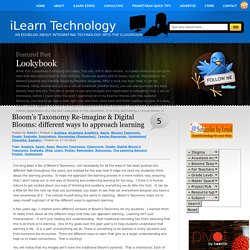
It helps me approach the learning process in a more holistic way, ensuring that I don’t camp out in one way of thinking and evidencing learning for too long. I think it is human nature to get excited about one way of thinking and suddenly everything we do falls into that. It can be a little bit like the new car that you purchased, you begin to see that car everywhere because you have a new awareness of it. I’ve noticed myself doing the same in teaching. Bloom’s Taxonomy: The 21st Century Version. So much have been written about Bloom’s taxonomy; one click in a search engine will flood your page with hundreds of articles all of which revolve around this taxonomy.

Only few are those who have tried to customize it to fit in the 21st century educational paradigm. As a fan of Bloom’s pedagogy and being a classroom practitioner, I always look for new ways to improve my learning and teaching, and honestly speaking , if you are a teacher/ educator and still do not understand Bloom’s taxonomy then you are missing out on a great educational resource.
The following article is a summary and a fruit of my long painstaking research in the field of Bloom’s taxonomy. The purpose is to help teachers grow professionally and provide them with a solid informational background on how to better understand and apply Bloom’s taxonomy in classrooms in the light of the new technological advances and innovations. 1 – The cognitive : The intellectual or knowledge based domain consisted of 6 levels .
The Differentiator. Try Respondo!

→ ← Back to Byrdseed.com The Differentiator The Differentiator is based on Bloom's Taxonomy, Kaplan and Gould's Depth and Complexity, and David Chung's product menu. Try It In: French Dutch • Tweet It • Like Byrdseed • Pin It Students will judge the ethics of the [click to edit] using a textbook and create an essay in groups of three. Bloom's Digital Taxonomy and Web 2 Tools by pip cleaves on Prezi. Bloom’s Taxonomy Bloomin’ Pinwheel. Over the past few weeks I have been sharing some of my Boom’s Taxonomy re-imagines.
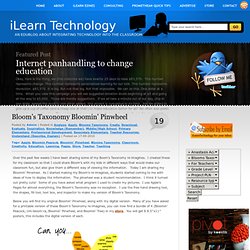
I created these for my classroom so that I could share Bloom’s with my kids in different ways that would make our classroom fun, but also give them a different way of viewing the information. Today I am sharing my Bloomin’ Pinwheel. As I started making my Bloom’s re-imagines, students started coming to me with ideas of how to display the information. The pinwheel was a student recommendation. I think it turned out pretty cute! Below you will find my original Bloomin’ Pinwheel, along with my digital version. Here are links to the digital tools in my Boomin’ Pinwheel: Remember: BBC Skillwise- Spelling City- Starfall- Bloom's Digital Taxonomy. Search Results » blooms. This post is in response to a Newsweek article titled “What if You Could Learn Everything” “Imagine every student has a tireless personal tutor, an artificially intelligent and inexhaustible companion that magically knows everything, knows the student, and helps her learn what she needs to know.”
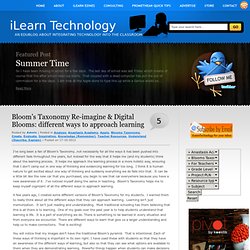
Jose Ferreira, the CEO of Knewton, has made this artificially intelligent companion a reality for k-12 students. He has partnered with three curriculum companies including Pearson, MacMillan, and Houghton Mifflin Harcourt as part of his vision for making Knewton the adaptive learning tool that will make textbooks obsolete. This “adaptive learning will help each user find the exact right piece of content needed, in the exact right format, at the exact right time, based on previous patterns of use… Knewton, at base, is a recommendation engine but for learning.
Rather than the set of all Web pages or all movies, the learning data set is, more or less, the universe of all facts. The Modern Taxonomy Wheel. 21st Century Pedagogy. Even if you have a 21st Century classroom(flexible and adaptable); even if you are a 21st Century teacher ; (an adaptor, a communicator, a leader and a learner, a visionary and a model, a collaborator and risk taker) even if your curriculum reflects the new paradigm and you have the facilities and resources that could enable 21st century learning – you will only be a 21st century teacher if how you teach changes as well.
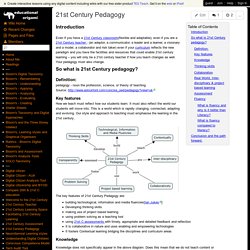
Your pedagogy must also change. Definition: pedagogy - noun the profession, science, or theory of teaching. Source: Key features How we teach must reflect how our students learn. Knowledge Knowledge does not specifically appear in the above diagram. We need to teach knowledge or content in context with the tasks and activities the students are undertaking. Thinking skills Thinking Skills are a key area. Collaboration The 21st century is an age of collaboration as well as the Information Age. 21st Century students, our digital natives, are collaborative. Assessment Fluency. Taxonomía de Bloom para la Era Digital. Andrew Churches Descargue este documento en formato PDF La Taxonomía de Bloom y la Taxonomía Revisada de Bloom [1] son herramientas clave para los docentes y los encargados del diseño de capacitaciones.
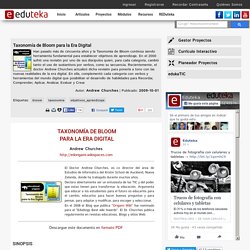
Benjamín Bloom publicó la taxonomía original en los años de 1950 y Lorin Anderson y Krathwohl le hicieron revisiones en el 2000 [1]. Pero desde la más reciente publicación de la taxonomía han ocurrido muchos cambios y desarrollos que deben tenerse en cuenta. Educational-origami - home. Digital Bloom's Taxonomy.